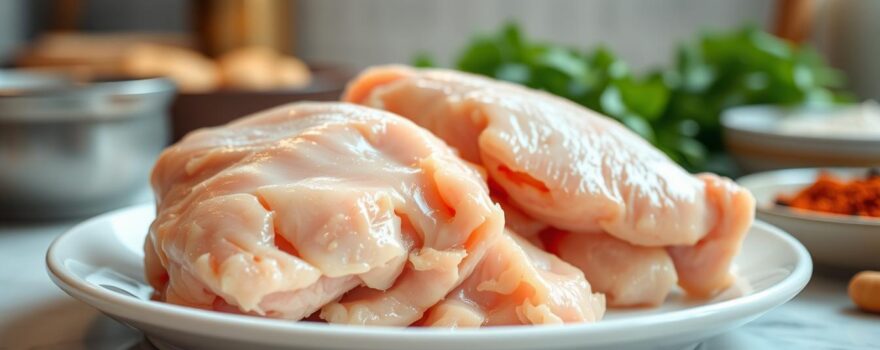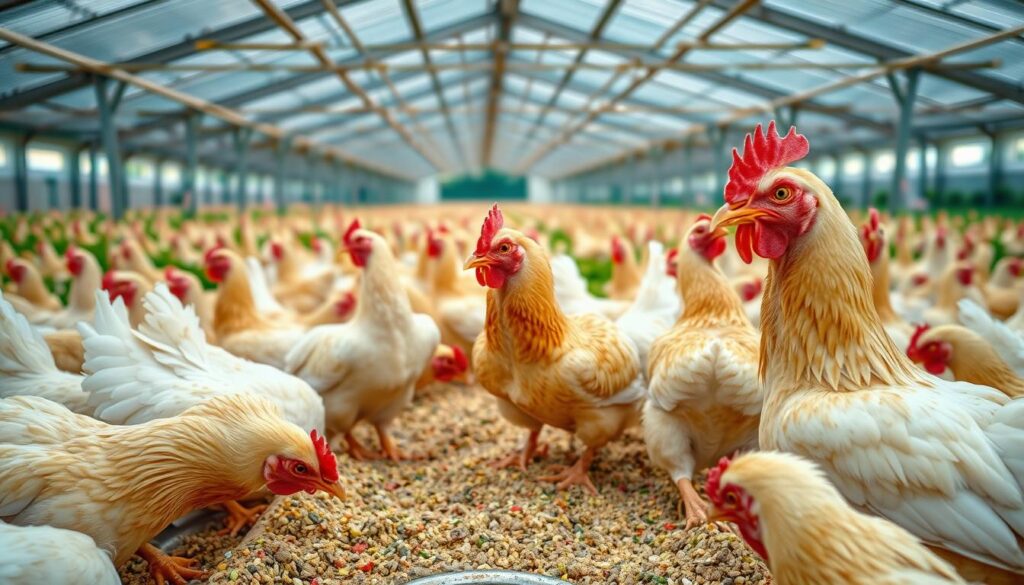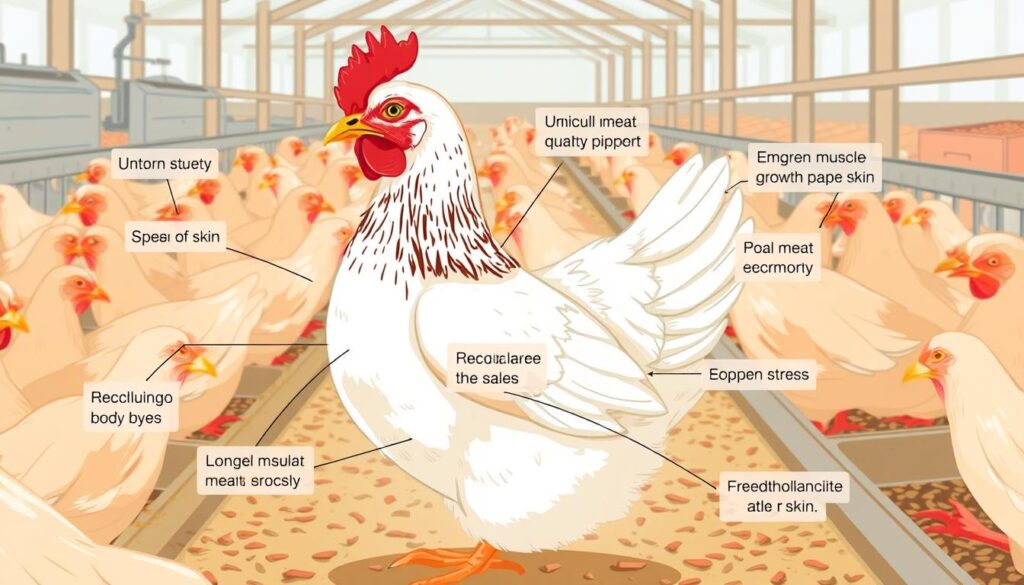
The broiler production industry has grown a lot. Now, it’s focusing on making broiler meat better. Things like how it looks, feels, tastes, and smells are very important. These factors decide if people like the meat or not.
Broiler meat quality is still a big challenge. Genetics, food, living conditions, and how it’s processed all matter. Fixing these areas is key to avoiding meat problems and making customers happy.
Key Takeaways
- Meat quality is a critical factor in the broiler production industry, influencing consumer perception and acceptance.
- Genetic selection, nutritional strategies, housing environments, and processing techniques play a vital role in maintaining consistent broiler meat quality.
- Addressing common meat quality issues, such as color defects, texture problems, and emerging muscle disorders, is essential for the industry’s growth.
- Comprehensive management practices throughout the broiler production lifecycle can help prevent and mitigate meat quality challenges.
- Adopting a holistic approach to broiler health, nutrition, and processing is key to delivering high-quality, consistent poultry products to consumers.
Introduction to Meat Quality in Broiler Chickens
“Meat quality” covers many aspects that make poultry meat desirable. It includes physical, chemical, and sensory properties. The focus has moved to improving broiler meat quality as the industry grows.
Definition and Importance of Meat Quality
Meat quality is key to the success of broiler chickens. It’s shaped by the broiler meat quality, bird nutrition, and management. High-quality poultry meat quality definition is crucial for meeting consumer demands for healthy, tasty, and nutritious meat.
Factors Affecting Broiler Meat Quality
- Nutrition of birds: The diet composition, including the levels of key nutrients and additives, can significantly impact the factors affecting broiler meat quality.
- Management of poultry meat production: Factors such as housing, environmental conditions, and pre-slaughter handling can influence the final meat quality.
- Post-slaughter biochemical changes: The rate and extent of chemical and physical alterations during processing and storage can affect meat characteristics like tenderness and color.
- Genetic variation: Selective breeding for desired traits can potentially enhance specific aspects of broiler meat quality.
“Maintaining high-quality broiler meat is essential to meet the evolving preferences of consumers, who increasingly demand wholesome, flavorful, and nutritious poultry products.”
Understanding the factors affecting broiler meat quality helps producers and researchers. They can work on strategies to improve meat quality. This meets the growing demand for better poultry products.
Appearance and Color of Broiler Meat
The look of poultry meat is very important to buyers. They see it as a sign of freshness and quality. Things like pigments, what the birds eat, how they are processed, and the bird’s genetics all play a part in its color.
Factors Affecting Meat Color
Many things can change the color of broiler meat. Muscle type, genetics, and how it’s processed are key. Different parts of the bird can look different, too.
Color Variations and Defects
Poultry meat can have color issues like mottling, paleness, and bruises. These can make the meat look bad and affect how people see it. Knowing what causes these problems is important for keeping the meat quality high.
| Color Defect | Characteristics | Potential Causes |
|---|---|---|
| Mottling | Irregular patches of color on the meat surface | Stress, genetic factors, and processing conditions |
| Paleness (PSE-like) | Pale, soft, and exudative appearance | Heat stress, pre-slaughter handling, and genetic factors |
| Darkness | Abnormally dark color of the meat | Stress, poor bleeding, and genetic factors |
| Bruises | Discolored areas due to trauma | Rough handling during transport and processing |
| Bone Darkening | Discoloration of the bone and surrounding meat | Genetic factors, mineral deficiencies, and processing conditions |
Understanding what affects broiler meat color helps producers and processors. They can work to avoid and fix these issues. This ensures the meat looks good and appealing to buyers.
Texture and Tenderness of Broiler Meat
Texture is key when it comes to how much people like poultry meat. The texture of broiler meat comes from its water content and muscle proteins. Water that sticks to the proteins makes the meat firmer.
Factors Affecting Meat Tenderness
Several things can make broiler meat tender or tough:
- Maturity of the connective tissues
- Contractile state of the myofibrillar proteins
- Environmental stress experienced by the birds
- Scalding temperatures during processing
About 29% of all carcasses in the United States are downgraded because of quality issues. Most of these issues are due to bruises. Research shows that bruises can change the color of the meat, from red to green, and back to normal within 120 hours (Gregory, 1992).
How the meat is handled before slaughter also matters. Early deboning can make the meat tough. But waiting 6 hours before deboning makes it tender in most cases (Figure 2).
Using electrical stimulation after slaughter can make the meat tender faster. It can be tender in just two hours, saving time and money for processors.
“Texture and color are very important for poultry meat quality. Things like the bird’s age, sex, and diet, as well as how it’s handled and processed, affect its appearance and tenderness.”
How to Prevent Common Meat Quality Issues in Broiler Chickens
Keeping broiler meat quality high is key for both buyers and producers. To avoid common meat quality problems, a detailed plan is needed. This plan should cover nutrition, management, processing, and genetics. By focusing on these areas, producers can reduce bad meat traits and offer a consistent, top-quality product.
Nutritional Strategies
Nutrition is vital for broiler meat quality. The right mix of fatty acids and special feed additives are crucial. For example, adjusting omega-3 to omega-6 fatty acid ratios can make meat look better and taste softer. Also, adding antioxidants like vitamin E can help meat stay fresh longer.
Management Practices
Good management practices help prevent meat quality issues. Keeping the birds in the right environment, like the right temperature and air, is important. It helps reduce stress and keeps the birds healthy. Also, how birds are handled before slaughter affects the meat’s quality.
Processing Techniques
The way meat is processed is key to its quality. Using the best methods for stunning, scalding, and chilling helps keep meat quality high. Techniques like marinating or injecting can also make meat more tender and flavorful.
Genetic Selection
Choosing the right genetics is another strategy. By picking birds that are likely to have better meat, producers can improve meat quality over time. This means better meat color, texture, and how well it holds water.
By looking at all these areas, producers can stop common meat quality problems. This way, they can give consumers a consistently high-quality broiler meat product.
Nutritional Strategies for Broiler Meat Quality
The diet of broilers greatly affects the quality of their meat. Broiler nutrition and meat quality are closely linked. Factors like dietary fatty acids and feed additives play big roles in meat quality.
Role of Dietary Fatty Acids
The fatty acid profile of broiler meat comes from the feed. Changing the fatty acids in feed can change the meat’s fatty acid content. This can make the meat more nutritious and taste better.
Impact of Feed Additives
Feed additives, like antioxidants and vitamins, also impact meat quality. They can change the meat’s color, texture, and nutritional value. For example, antioxidants can reduce muscle disorders and improve meat quality.
| Nutritional Factor | Effect on Broiler Meat Quality |
|---|---|
| Dietary Fatty Acids | Alters the fatty acid composition of meat, impacting nutritional value and sensory characteristics |
| Antioxidant Feed Additives | Reduces incidence of muscle disorders, improves color and texture of meat |
| Mineral and Vitamin Additives | Enhances the nutritional profile of meat, contributing to overall meat quality |
Broiler producers can improve meat quality by using the right nutrition. This can make the meat better in color, texture, and nutrition. It can also make consumers happier and increase the meat’s value.
“Proper nutritional management is essential for ensuring high-quality broiler meat that meets consumer expectations and industry standards.”
Management Practices for Broiler Meat Quality
Keeping broiler management practices in check is key to quality meat. Many factors, from housing to pre-slaughter handling, affect the final product.
Housing and Environmental Conditions
The broiler’s living space greatly influences meat quality. Stocking density, ventilation, and litter management are important. For example, a RSPCA-approved stocking density can improve meat quality.
Good lighting, like 23 hours a day, boosts broiler performance. Keeping litter moisture under 30% and ensuring quality water are also vital for health.
Pre-Slaughter Handling and Transport
Handling and transport before slaughter also matter. Stress and temperature changes can lead to poor meat quality. Proper handling and transport help maintain quality.
Studies show that a 14-day break between flocks can cut pathogen risks by 90%. Daily biosecurity practices also reduce pathogen spread.
| Management Practices | Impact on Meat Quality |
|---|---|
| Stocking Density | Affects intramuscular fat content, cooking and drip loss, carcass and breast yields |
| Lighting Program | Improves broiler performance and profitability |
| Litter Management | Maintaining ideal moisture content ( |
| Water Quality | Proper pH (6.5-7.8) and accessibility are critical |
| Pre-Slaughter Handling | Minimizes stress and preserves meat characteristics |
| Biosecurity Practices | Reduce pathogen transmission between flocks |
By managing these factors well, producers can improve broiler meat quality. This ensures a consistent, high-quality product for consumers.

Processing Techniques for Broiler Meat Quality
The journey from broiler slaughter to the final meat product is key to meat quality. Changes after death affect the meat’s texture, color, and quality. Improving processing steps can keep broiler meat up to standard.
Primary Processing and Meat Quality
Temperature after death affects the meat’s quality. Proper stunning, bleeding, and scalding are vital. They help keep the meat’s color even and prevent defects.
For example, scalding at the right temperature helps remove feathers without discoloring the meat. This is due to even moisture loss.
Further Processing and Meat Quality
Further processing also impacts broiler meat’s quality. Marination, for instance, can make the meat safer and better tasting. Sous vide cooking improves the meat’s taste and texture.
Handling live broilers before slaughter is also crucial. Reducing stress and injuries helps avoid quality issues like PSE meat.
“Optimizing processing techniques, from primary processing to further processing, can help maintain the desirable characteristics of broiler meat.”
Genetic Selection for Broiler Meat Quality
Genetic differences in broiler chickens greatly affect meat quality. Studies show that the heritability of meat traits in broilers is very high, from 0.35 to 0.81. This makes genetic selection a key method for better broiler meat quality.
A University of Arkansas study looked at genetic and environmental effects on broiler meat quality. They selected broilers for high (HBY4) and low (LBY4) breast yield. The HBY4 line showed better muscle fiber development than LBY4 at two key stages.
Another study on the MRB line found differences in breast yield among sire families. The highest yield families also had better dressing percentages. Thermal manipulation during embryonic days 15-17 improved breast yield and reduced woody breast severity.
| Trait | Heritability Estimate |
|---|---|
| Breast Yield | 0.35 – 0.81 |
| Meat Color | 0.40 – 0.60 |
| Meat Tenderness | 0.30 – 0.50 |
These studies show how broiler genetics and meat quality are crucial for better meat. By breeding for better meat traits, producers can meet consumer demands for quality.
Emerging Meat Quality Issues in Broilers
The poultry industry is facing new challenges with broiler meat quality. Two major issues are white striping and woody breast condition. These problems affect how the meat looks, feels, and is processed.
White Striping and Woody Breast Condition
White striping shows as white lines in the muscle fibers due to too much fat. It mainly happens in the breast and thighs of fast-growing chickens. The cause is thought to be related to a lack of oxygen, which messes up how the chicken’s body works.
Woody breast is another problem that makes the meat look and process differently. It’s seen all over the world but we still don’t know exactly why it happens. Nutrition, how the chickens are raised, and their genetics might play a role.
Spaghetti Meat and Other Muscle Disorders
There’s also spaghetti meat, where the breast becomes soft and looks like spaghetti. A study found 36% of breast fillets had this issue. It might be an early sign of woody breast.
Poultry companies are working hard to keep the meat quality high while also keeping costs down. They want to reduce the economic losses from these meat quality problems in broilers.

“Selective breeding in the meat industry yields more breast meat but leaves young birds prone to painful abnormalities.”
| Meat Quality Issue | Description | Potential Causes |
|---|---|---|
| White Striping | White striations along muscle fibers due to excessive fat deposition | Fast growth and high breast yield in modern broiler breeds, hypoxia |
| Woody Breast Condition | Hardening of the breast muscle, affecting appearance and processing | Nutrition, management, and genetic factors |
| Spaghetti Meat | Soft and mushy breast muscle, with a fraying or spaghetti-like appearance | May be an early stage of woody breast development |
Conclusion
Keeping broiler meat quality high is key for meeting consumer needs and helping the poultry industry grow. By looking at nutrition, management, processing, and genetics, producers can tackle common meat quality problems in broiler chickens. This is important for the production process.
The United States is the biggest poultry meat producer in the world. It has a big role in making sure broiler products are of high quality and safe. With more people eating poultry meat, the industry must stay on top of new meat quality issues.
Research and efforts from the whole industry are needed to tackle problems like white striping and woody breast. By focusing on these issues, producers can make consumers happier, stay competitive, and help the poultry sector thrive.